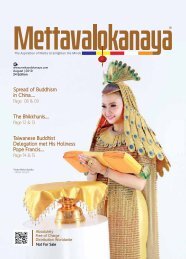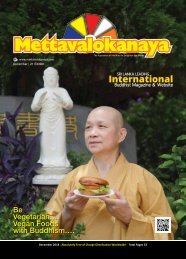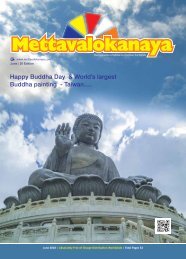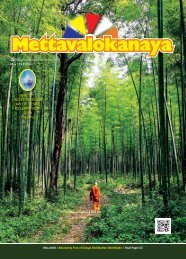Mettavalokanaya_Buddhist_Magazine_March_2019
“Mettavalokanaya” International Monthly Buddhist Magazine has been successfully distributed to 40 countries including all districts across Sri Lanka and now “Mettavalokanaya” is Sri Lankan Most Popular & Leading monthly Buddhist Magazine.
“Mettavalokanaya” International Monthly Buddhist Magazine has been successfully distributed to 40 countries including all districts across Sri Lanka and now “Mettavalokanaya” is Sri Lankan Most Popular & Leading monthly Buddhist Magazine.
You also want an ePaper? Increase the reach of your titles
YUMPU automatically turns print PDFs into web optimized ePapers that Google loves.
“The<br />
Meaningful<br />
Monastic<br />
Life”….<br />
Normally, a man or women would<br />
come to stay at a monastery<br />
where they think they would<br />
like to train. Sometimes they<br />
visit several monasteries to find where<br />
seems best. Most monasteries allow<br />
someone to stay to see if they feel well<br />
there initially for one week or two weeks.<br />
If one feels inclined to stay and<br />
enter into the training at a particularly<br />
monastery, they should make their<br />
aspiration known to the teacher, abbot<br />
or abbess there. If it is agreeable to the<br />
teacher and the monastic community,<br />
the aspirant is welcomed to return. Upon<br />
their return they undertake the eight<br />
precepts (if they hadn’t already) as a prepostulant<br />
or nekkhamma, normally with<br />
an as yet unshaven head, wearing white<br />
or black and white clothing. The prepostulant’s<br />
eight precepts are the same<br />
as the layperson’s five precepts plus<br />
three additional renunciate precepts,<br />
as well as the significant change in the<br />
3rd precept from no sexual misconduct,<br />
to brahmacarya or no sexual conduct<br />
whatsoever. The fundamental Buddhism<br />
is summarised by Shakyamuni in the<br />
Dhammapada: Not to do any evil, To<br />
cultivate good, To purify one’s mind,<br />
This is the teaching of the Buddhas. It is<br />
simple but not easy. When a kid is three<br />
years old, he knows it. However, when<br />
he is over 80 years old, he cannot really<br />
practice it in his daily life.<br />
Morality - Morality is the<br />
preliminary stage on the path to<br />
attain Buddhahood. It is a necessary<br />
condition, though not sufficient, leading<br />
to wisdom. It is absolutely essential for<br />
enlightenment. Morality in Buddhism is<br />
a rational and practical mode based on<br />
verifiable facts and individual experience,<br />
which is regarded as the one of the most<br />
perfect moral code ever known in the<br />
world.<br />
What is the criterion of morality<br />
according to Buddhism? In the<br />
admonition given by the Buddha to<br />
young Rahula, there is the answer. If<br />
there is a deed, Rahula, you wish to do,<br />
reflect thus: Is this deed conducive to my<br />
harm, or to others’ harm, or to that of<br />
both? Then is this a bad deed entailing<br />
suffering. From such a deed, you must<br />
desist. If there is a deed you wish to do,<br />
reflect thus: Is this deed not conducive<br />
to my harm, nor to others’ harm, nor<br />
to that of both? Then is this a good<br />
deed entailing happiness. Such a deed<br />
you must do again and again. Thus, in<br />
assessing morality, a <strong>Buddhist</strong> takes into<br />
consideration of the interests of both<br />
himself and others - animals not excluded.<br />
To understand the exceptionally high<br />
standard of morality, one can vigorously<br />
study Dhammapada, Sigalovada Sutra,<br />
Vyagghapajja Sutra, Mangala Sutra,<br />
Mutta Sutra, Parabhara Sutra, Vassla<br />
Sutra, Dhammika Sutra. Good deeds<br />
are essential for one’s emancipation,<br />
but when once the ultimate goal of holy<br />
life or enlightenment is attained, one<br />
transcends both good and evil. Morality<br />
is a means to an end, but not an end in<br />
itself.<br />
Three Poisons / Three Evil Roots -<br />
In Flower Adornment Sutra, it says that;<br />
For all bad Karma created in the past,<br />
Based upon beginningless greed, hatred<br />
and delusion, And born of body, mouth<br />
and mind,<br />
I now repent and reform. It is<br />
the well-known Repentance Verse in<br />
Buddhism. In Buddhism, the distinction<br />
between what is good and what is bad<br />
is simple. It hinges on the intention<br />
or motivation from which an action<br />
originates. The deed which is associated<br />
with greed / attachment, hatred / ill<br />
will, delusion / stupidity is evil. Greed,<br />
hatred and delusion are called the Three<br />
Poisons or Three Evil Roots, which are<br />
the primary source of all evil deed. It<br />
is the Three Poisons that create all bad<br />
Karma, resulting all kinds of suffering in<br />
accordance with the Principle of Cause<br />
and Effect. The Three Poisons are also<br />
obstacles to the attainment of good<br />
Karma. Thus we have to abandon them<br />
by all means.<br />
Greed - Greed is the cause of many<br />
offences. The five greedy desires are:<br />
wealth, sex, fame, eating and sleeping.<br />
Greedy desire is endless and therefore<br />
can never be satisfied. The lesser the<br />
greedy desire, the happier and more<br />
satisfied we are. The best prescription to<br />
deal with greed is in giving away. Anger<br />
- Hatred to people is another cause of<br />
evil deed. We should not lose temper<br />
and get angry when we are unhappy. We<br />
should be calm and patient. Delusion - It<br />
means the persistent belief in something<br />
false and distorted. We have to observe<br />
and think in an objective and rational<br />
manner, so as to avoid prejudice and<br />
misunderstanding. For instance, if<br />
we don’t believe in cause and effect,<br />
and then commit offence frequently<br />
and heavily, we will suffer from the<br />
retribution.<br />
After staying for some time as a<br />
pre-postulant (normally 2 weeks to 2<br />
or 3 months), if both the aspirant and<br />
the teacher as well as the monastic<br />
community feel amiable about going<br />
ahead, the aspirant may request<br />
ordination as an anagarika. Anāgārika<br />
means homeless one due to their having<br />
left home life, sought refuge and being<br />
accepted as postulants in the monastery.<br />
In English we call anagarikas at this stage<br />
“postulants, aspirants” or “candidates.”<br />
Anāgārikā (with a long “a” at the end)<br />
is the female form, anāgārika the male<br />
form. The anagarika has a shaven<br />
head, wears white robes and keeps the<br />
8 precepts. The anagarika period is<br />
normally around a year, but sometimes<br />
can be as little as six months, or as long<br />
as several years, depending on individual<br />
circumstances.<br />
As a postulant, one is still officially<br />
a lay person, and as such still able to<br />
use money, hold property and finances<br />
and support oneself. Although normally<br />
lodging and food are shared by the<br />
monastic community with anagarikas at<br />
a monastery, special health care needs,<br />
travel (not related to the training) or<br />
other such expenses, are still covered<br />
by the anagarika herself. Most nuns<br />
in Burma and Thailand, for whom<br />
novice and full ordination has not<br />
been available for some time, live as<br />
anagarikas for short-term or long-term<br />
monastic retreat in this way with the<br />
“uposatha” eight precepts. Thai, Lao<br />
and Cambodian angarikas are called<br />
maechees and donchees. In Burma the<br />
anagarikas may wear light-pink, peach<br />
or dark-brown colored robes and are<br />
called Sayalay or thilashin. A samaneri is<br />
a female novice samana, or a samana-intraining.<br />
A samana is a monastic recluse.<br />
Samaneri is the female form of the word;<br />
samanera is the male form.<br />
After an average of a year as an<br />
anagarika, with the approval of her<br />
teacher, an anagarika may request the<br />
samaneri pabbaja, the “going forth”<br />
as a novice into the monastic life. If an<br />
aspirant for novice ordination is under<br />
the legal age of adulthood (or age 20),<br />
she must have the permission of her<br />
parents or guardians in order to receive<br />
novice ordination. Novices undertake<br />
the ten novice precepts, which include<br />
8 precepts plus the additional precept<br />
of not handling or keeping money. In<br />
most forest monasteries, novices also no<br />
longer drive cars. The novice precepts<br />
and training are exactly the same for<br />
male and female novice trainees. In<br />
addition to the going forth, a novice<br />
also takes “dependancy” upon the elder<br />
Sangha member who will be her acariya<br />
- her personal teacher, mentor and guide<br />
through the ordination process.<br />
Again, in the absence of<br />
bhikkhunis, bhikkhus are both permitted<br />
and enjoined by the Vinaya to give<br />
both the novice and probationary<br />
novice ordination to qualified women<br />
candidates. In the currently (at least in<br />
the West!) very rare event that a woman<br />
has married very young, or become<br />
a novice as a young girl, she might be<br />
qualified to be ordained as a sikkhamana<br />
from age 10 or age 18 respectively. For a<br />
child bride, having proven her maturity<br />
and responsibility by completing 2 vassas<br />
of the sikkhamana training, she may be<br />
fully ordained as a bhikkhuni even before<br />
age 20. The Vinaya normally considers<br />
age 20 to be the age of adulthood,<br />
at which time one may, if having met<br />
all requisite conditions, request full<br />
ordination, the bhikkhuni upasampada,<br />
from the monastic community. It is<br />
noteworthy that, in some Thai, Korean,<br />
Chinese and Tibetan tradition monastic<br />
communities, women currently receive<br />
and complete the sikkhamana ordination<br />
and training for two years before fully<br />
ordaining, no matter what their age. A<br />
bhikkhuni is literally an almswoman or<br />
female alms mendicant. Bhikkhuni is the<br />
feminine form of bhikkhu.<br />
“Women<br />
upholding the<br />
Dhamma”….<br />
USA<br />
Preceptor, The Chief<br />
Founding Abbes of<br />
Dhammadharini Monastery<br />
& Senior Teacher in<br />
Residence at Aranya Bodhi<br />
Hermitage, California, USA<br />
Most Venerable Bhikkhuni<br />
Ayya Tathaloka Mahatheri<br />
Sanghatheri,<br />
16 l <strong>Mettavalokanaya</strong> l <strong>March</strong> l <strong>2019</strong> l www.mettavalokanaya.com www.mettavalokanaya.com l <strong>2019</strong> l <strong>March</strong> l <strong>Mettavalokanaya</strong> l 17
















